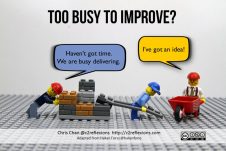Continuous improvement is not an option is taking the best opportunity and build advantages, but what opportunity exactly?
On digitalization services and software development such as mobile applications, the goal is satisfying customer needs thanks to functionalities performed through scripting. In this case, Scrum or other agile methodologies meet this goal utterly. Thanks of continuous delivering, the client can learn from experience and take the right decision which is accomplished by the developer team. Consequently, work is progressively being more and more accurate on value generation. That makes more feasible reaching customer satisfaction.

We could think that with this introduction the conclusion has been uncovered. The fact is that previous lines are showing just a methodology to define and develop work. Nevertheless, if we take a minute to draw an image on our minds, we could see the developer team doing different tasks during this process. These tasks include gathering information, communication, scripting, tests, etc. It is evident, while the team is gaining more and more experience they will do better. Furthermore, it is easy to imagine how different teams reach different performance. Then we understand how there is something else than methodology and how important is.
We have reached the answer, this is the opportunity: accelerate the process of improving performance and being better. In other words: make our internal engine better and grow the value we send to our clients, if they reach more profits thanks to high quality solutions, we will do as well.
How could we do this? How could we go further?
The proposal is using Lean knowledge to study agile Scrum processes. We use it to detect the best way of continuous improvement. This famous mindset aims to improve the results and reduces effort at the same time.
Lean was born on 1900 from Toyota Production System (TPS). After that, it has had massive diffusion and adjustments such as Lean Startup. It happens because the Lean mindset is remarkably useful in all activities, even in a personal life. Perhaps surprising but Scrum has been created using Lean philosophy. As software development is an activity different from others, needed something new. Therefore it reached the next level when Scrum arrives. Some other tools used in software development maintain even their name, such as Kanban, those cards inspired by Japanese in EEUU market when they tried to catch new ideas for inventory control systems.
Once again, after reading the previous paragraph, we could think:
- As Scrum comes from Lean, is the work done already?
It is important to remember our mission here. We are settled to catch the opportunity: “improve our internal engine”. Scrum is an improvement, but we want more. With that in mind we are going to use Lean on agile, seems challenging but exciting. The bigger the challenge, the bigger are the outcomes and why not, more fun.
Let’s see where it leads us.

6 Key points about improvement. Bright ideas to improve business
Key points to improve business are the best way to settle a base. On that way, we have a clear picture on our mind which will be an orientation to use the tools shown on next sections:
- People are the most important. Improvements are focused on our clients and are for making easier the work of our developer teams.
- Everyone makes errors and have weak points the key is to learn from them and feel good in an overcome process.
- Improvements are a source of resources, not a sink.
- Agile continuous improvement process will be integrated into developed team workflow.
- Effortless prioritisation methodology. No waste time by taking decisions.
- Accelerate learning from experience.

Improvement Toolbox: Indicators, VSM, Management
Now we know what we want to do, but we need a toolkit to build our improvements factory.
Andon, KPI or indicators?
Andon, KPI or indicators are different names, but all of them have something in common and that is what matter. Let’s see what it is.
From sure this is the most important tool in the agile continuous improvement process. Every process needs support to make decisions. Additionally, if it is right defined, this support makes you concentrate on the objective. It is important to notice the fact that we do what we are looking at. If you want to comb your hair you need a mirror, of course, you can do without it but how could you be sure about the result?
As we do what we are looking at, the point is defining a way to see those things we want to create.

Andon
Andon is the name used by Lean philosophy. It focuses on problems detection so that it is an alarms system. Then awareness about issues is remarkably fast and accomplishes rapid reactions. Visualisation system and staff consciousness about quality are the two pillars to make work right. This approach shares with us interesting things to take into account in our agile improvement process:
- Fast problem detection.
- Early alert.
On the other hand, we need to adapt it having in mind:
- Adaptation to agile processes.
- Use technology advantages available on software development companies.
KPIs
KPI or Key Performance Indicators are widely used in business as a way to track results regarding objectives. They are born from company strategy. Furthermore, each department in a company can design its own KPIs, but they should be aligned with general ones.
The most interesting concepts here are:
- Indicators alignment with company strategy.
- They should support decisions at a high level.
Once again, we need to go one step further:
- Complete team commitment and awareness add power to this tool. Extension onto all the company team it is necessary.
- As a way to achieve the previous point, we need to simplify gathering information and visualisation of KPIs.
Indicators
When people think about an enhacement process, they will see it as difficult, impossible or hard to accomplish.
The reason for negative thoughts is because daily work normally is hard, a huge amount of workload and issues to solve. Therefore, the indicator it is the best approach because it should make our life easier. Simplicity is the most important thing to visualise how we are improving.
The best path is the definition of simplified indicators and they should have all lessons learned in KPIs and Andon definitions.
An important feature to add here is considering a general or universal indicator. As it should help anyone in our company, everyone should be affected by it and should be understood without explanation.
The question is: what indicators we should use? We will see a proposal later in the two indicator sections.

VSM (Value Stream Map), using map of treasure
VSM is a technique from Lean Manufacturing toolbox. It depicts how our company works to produce client’s value. In other words, all the different tasks accomplished which are necessary to create the client delivery. Consequently, we have a map to locate us and make easier the improvement opportunity identification and tracking.
The challenge here is the difficulty of detecting cascade process. Cascade means one task after another to produce step by step the final delivery.
Where exactly is the challenge?
Agile Scrum process has not got cascade.
When you are starting dealing with improvements, rare is when you do not find an issue that seems to destroy and ruin all work. The first thought is “impossible, no way to do this”. But that is always a lie – not believe in your mind lies –.
On this case, the solution is to explore working patterns. There is always a relation between different tasks and more tasks than obvious. Thanks to that reflexion is possible to build the VSM in agile processes.

Distributed management
Every process needs a promoter who will be the reference and who overcome progress barriers when an extra effort is necessary. That is the best way to ensure progress. The promoter is an essential role; nevertheless, management should not be centralised here.
Even more important is enrol all company team on improvement process. Everyone should know the advantages of improvement process and how it works.
Notice once again our mission: develop “agile continuous improvement process”, therefore each person and team will be able to manage improvements.
All previous lines lead us towards distributed management which ensures agile process, as simple as possible. Some advantages are:
- Direct connection of management with who which are working on it so that communication and agility are improved.
- Perform improvements are easier.
- Execution is speedy; we need just the improvement opportunity identification and team to take it a reality.
- Fewer resources are necessary.

Economic indicator: time is gold
Use time to provide as much customer value as possible, that is the key.
Perhaps you were waiting for an explanation how to extract ROI (Return Of Investment), EBITDA (Earnings Before Interest, Taxes, Depreciation, and Amortisation), Net Liquid Assets, etc. But agile improvement needs simplification; we need use time in the best way to produce more. If we increase the value of our time, surely the economic indicators will be boosted.
We are going to imagine a company as a factory that fuels with time. The point is using our time to produce as much value as possible. The Lean approach helps us on this task since it has a systematic approach able to identify and reduce time wasting. In software applications, the objective is to produce as many valuable functionalities as possible per time unit.
Even more exciting is how easy we can measure this indicator: just need a stopwatch.
Now we can track how effective we produce value or in other words if our improvements are raising our profitability and are effective.

Customer quality indicator, using magnifying glass where needed
At this moment, we were dealing how to do better our internal activities. Besides, we need an indicator to show customers satisfaction with our work.
Quality is the most important indicator since all our work is for our clients, they are the reason of our existence. Quality indicators are which show us how we should prioritise. Most important improvements are those requested by customers.
Highlight also communication as a primary tool in all process. This mechanism comes from Scrum methodology where satisfactory communication with clients and commitment is a synonym of the best results. Therefore, communication is analogue of quality and some points of particular importance:
- How, when and with who of in client company define new functionalities.
- How, when and with who of client company define new functionalities.
- Understand how respecting sprints without interruption makes the best results.
- How to meet project budget. There is always an enormous amount of options; the key is select the proper one.

Due to the importance of customers, more than one indicator is recommended such as:
- Short and precise quality surveys.
- Identify and accomplish particular time tracking on those tasks connected with customer quality
Remember communication again as a critical indicator, asking the customer what improvements they need is the best indicator!
How to develop agile continuous improvement process
We have seen improvement as growing machine for our customer’s profits through high quality solutions and is easy to understand this fact as good news for us. Besides, we have covered key points, tools and have paid distinct attention to indicators. It is time now to compile all this information and understand how to use it. In the video (in Spanish), you can see also a real implementation of all this work.
At this point, we need just a base where we can build all the different situations. It is important to define some specs, which are powerful tools to reach the best implementation:
- Do not forget, we are depicting a process, but all that matters is people. It shall be a process at service of the team.
- The process should have minimum time consumption. Value is on improvement implementation not on process tasks.
- Avoid as much as possible adopt new tools. Try to perform agile continuous improvement process with those tools which are already implemented in your company.
- If necessary apply new tools. But, remember they should be as simple a possible.
- Pay particular attention to agile continuous improvement processes barriers. Detect all issues that make it go slower and react.
The final enhancement process depends on a lot of things although there are 5 common points on all of them. It is not necessarily going more in deep. If you want to see accurate information, then let’s see the video.
5 steps to deploy agile continuous improvement process
The best way to understand agile continuous improvement process is having a clear idea of the steps necessary. The video at the beginning shows a real implementation as a way to make easier understand enhancement process creation.
The steps to build the agile continuous improvement process are:
- Map tasks grouped by using VSM.
- Identify how to track and accomplish measurements as to build indicators.
- Define tracking of the process.
- Test process in a pilot. Do not start with all company.
- Learn and debug from experience.
We use a map to know where we are working which is VSM; furthermore, we need light from indicators to see what is happening. Everything else is learning by doing.

Digitalization, technology and applications make the highest profitability improvements
Digitalization is a transversal improvement which uses technology opportunities. It is important to realise that once we have detected barrier in our agile continuous improvement process, technology brings the way to overcome it. When improvements use digitalization with sense, profitability and customers satisfaction reach unsuspected levels. Just a mention of some technology tools:
- Multiplatform applications. Mobile and PC applications
- Cloud services.
- Hardware devices: Tablets, Smartphones, sensors, embedded systems, control systems, etc
- Incipient technology: Internet of the Things, Big Data, Business Intelligence, etc.
The key point here is having a suitable knowledge about the barrier, problem to solve or opportunity and then use the technology with sense and effectiveness.
Final insights: Quality for customer and well-being for the team
I would like to share with you my most personal understanding of agile continuous improvement.
Agile continuous improvement could be more than methodology and can be extended beyond the workplace. It is fascinating considering a way of personal growth. It is hard to explain with words what contributes to yourself.
Even when we see agile continuous enhanced just as a methodology I feel necessary something bigger than the individual. On this way appears something able to orient, inspire and motivate individuals. Continuous improvement fits perfectly with this idea: what matters are the solutions for clients, make the work environment better and more comfortable, not individuals or personal goals. As life usually has irony when better solutions for customers and teams are achieved, individuals feel better and they accomplish easier their goals.
Sometimes questions explain more than usual sentences:
- Can you imagine which can be the consequences of agile continuous improvement?
- Can you imagine what can be its impact?
- What can be its benefits?
- Do you see the connection with innovation?
- Do you see the connection with other company areas such as marketing? Any other?
- Can you imagine the difference between doing it or not?
- What is the cost of NOT doing agile continuous improvement?
There is always something to improve and something new to learn by doing it.

Thanks to Solid Gear for believing and being brave enough to make possible creating something different. I am proud of have been working with a team like this.





thank you very much
but what the relationship between the continuous improvement and competitive advantages??
The basis of continuous improvement is being better by giving value to customers. In point “VSM (Value Stream Map), using map of treasure” you can see how the map of all process has the goal of giving value to clients. Do it better than others is being more competitive, why? because you are giving same product cheaper if you do right, you can infact get more profitable at the same time. To understand this idea it is important to remember time a money waste if your are not working as good as possible, if someother doit they have the advantaje.
Furthermore, you can give more quality to customers which is also an advantaje. We drive our attention to that because our methodology is looking all the time to it, see points “Economic indicator: time is gold” and “Customer quality indicator, using magnifying glass where needed”